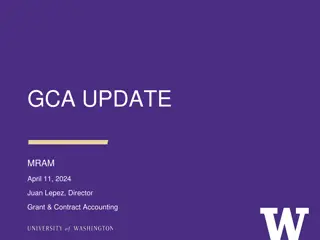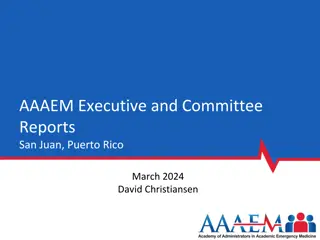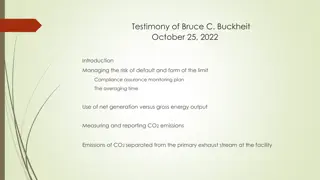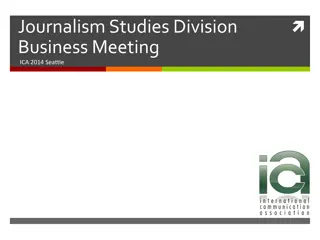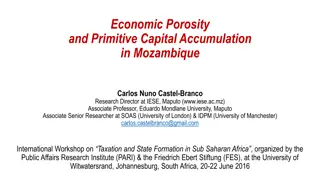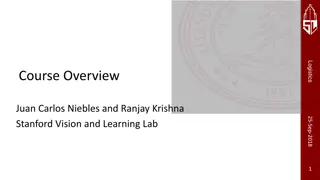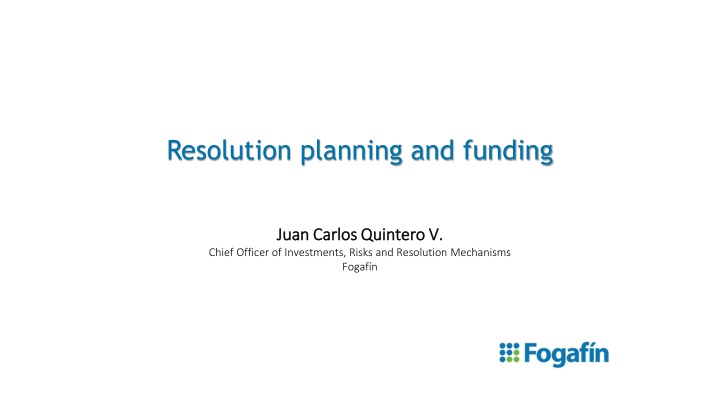
Resolution Planning and Funding in Financial Institutions
Explore the role of Deposit Insurance Agencies in handling systemic crises and the resolution mechanisms implemented by Fogafìn in Colombia to address financial institution failures. Learn about resolution planning, funding strategies, and private sector solutions in the event of weak banks or systemic issues.
Uploaded on | 2 Views
Download Presentation

Please find below an Image/Link to download the presentation.
The content on the website is provided AS IS for your information and personal use only. It may not be sold, licensed, or shared on other websites without obtaining consent from the author. If you encounter any issues during the download, it is possible that the publisher has removed the file from their server.
You are allowed to download the files provided on this website for personal or commercial use, subject to the condition that they are used lawfully. All files are the property of their respective owners.
The content on the website is provided AS IS for your information and personal use only. It may not be sold, licensed, or shared on other websites without obtaining consent from the author.
E N D
Presentation Transcript
Resolution planning and funding Juan Carlos Quintero V. Juan Carlos Quintero V. Chief Officer of Investments, Risks and Resolution Mechanisms Fogaf n
Introduction A deposit insurance system is not intended to deal, by itself, with systemically significant bank failures or a systemic crisis . In such cases all financial system safety- net participants must work together effectively. In addition, the costs of dealing with systemic failures should not be borne solely by the deposit insurance system but dealt with through other means such as by the state. 1 Q: What is the role of the Deposit Insurance Agency (DIA) in a systemic crisis? 1 Core principles for Effective Deposit Insurance Systems (2009)
Introduction Fogaf n (Colombia s DIA for financial institutions) was created in 1985, following an important financial crisis that forced the government to nationalize a significant part of the financial system, with two main purposes: Provide capital support for financial institutions without unduly benefiting shareholders, administrators or those responsible for the difficulties. Organize a deposit insurance scheme. A: In the case of Fogaf n, its role is not limited to non-systemic events. Resolution planning and funding
Resolution planning: how does resolution work Fogaf n: pay box plus (IADI s assessment) Closed Bank Resolution* (least-cost resolution principle) Purchase of assets and assignment of liabilities Liquidation and deposit payoff Is there a private sector solution to this situation? Does the closing affect the payment system of the economy? NO NO Weak bank YES YES Private Resolution Mechanisms Assets and liabilities transfer Merger and acquisition* Voluntary liquidation Open Bank Resolution* Open bank assistance Nationalization * Resolution mechanisms in which Fogaf n takes part.
Resolution planning: what have we been working in Development of operational plans (protocols with detailed processes , 2010-2014) Mergers and acquisitions Purchase and assumptions transactions Liquidation and payout Open bank assistance Revision of how the mechanisms are vs. how they should be (law) Purchase and assumptions transactions Liquidation and payout Working within the safety net Better coordination within the CCSSF Socializing current developments (living wills / bail in)
Resolution planning: challenges going forward Operational plans Testing and fine-tuning through simulations How the mechanisms are vs. how they should be Continue pushing with developed alternatives Open bank assistance External diagnostic Working within the safety net Involve other members in resolution Simulation that involves other safety-net participants
Resolution funding: how it is organized Resources should be ready to deal with a one time failure but also to support a systemic event. Asset Composition In June, the reserve reached US$ 4.6 billions (3.1% of the total deposits). 15% Asset composition: Negative correlation between assets and liabilities (small open economy) Local assets: non systemic events Foreign assets: systemic events 85% Foreign Assets Local Assets
Resolution funding: what have we done Eligible Deposits Growth and DIF Growth DIF as a Proportion of the Eligible Deposits Determine a target fund ratio Loss distribution function Risk tolerance of the DIS 25% 4.5% 15.8% 20% 15% 4.0% Search for ways to achieve it Higher premiums Reinsurance schemes Contingent credit lines 13.9% 10% 5% 3.5% 0% -5% 3.1% 3.0% -10% -15% Asset allocation Risk-based process Principles investment horizon -20% 2.5% jun.-10 jun.-11 jun.-12 jun.-13 mar.-11 sep.-11 sep.-10 sep.-12 sep.-13 dic.-09 mar.-10 dic.-10 dic.-11 mar.-12 dic.-12 mar.-13 dic.-13 mar.-14 / priorities: DIF as a proportion of the eligible deposits DIF annual growth Eligible deposits annual growth
Resolution funding: challenges going forward Target fund ratio Materialize ways to make achieve it Incorporate it explicitly Investments Continue the thought process: investment seminar Tranches / portfolio currency composition
Summing up Resolution planning: Detailed operational procedures and simulating Looking at best practices and pushing for change Resolution funding: Target funding level: looking for ways to achieve it Investment policies: increasing importance The DIA s role in systemic events Why not?
Thank you Juan Carlos Quintero V. Juan Carlos Quintero V. Juan.quintero@fogafin.gov.co Juan.quintero@fogafin.gov.co



